#calle gravina
Text
Gabriele Gravina calling Kosovare Asllani "this girl" as if she was just a total unknown swedish tourist who stayed a few days in Italy for a quick vacation and didn't enjoy it.
This man, jesus... I can't stand him.
8 notes
·
View notes
Text
the more i go over this drama, the more i am amazed at how theatrical it looks; as i said before, the camera work is very simple, may it be because it was 1969, may it be because it was made for tv, maybe it was even a conscious choice - but! the camera movements are so fluid in the way they follow the actors, focusing on the character's emotions and body language or distancing itself from the action to include thematics particulars from the set and give the scene more breath - im enamoured with how the kitchen scene with alyosha, ivan, smerdyakov and fyodor in the second episode is shot; first, the scene is set with a larger shot where grigory and smerdyakov are setting the table and fyodor and ivan are eating - might i add, giving ivan a cigar to smoke in this scene was chef kiss - then alyosha comes in and as the discussion progresses into more heavier themes the camera pans nervously from smerdyakov to ivan, the frame getting closer still, until it settles unto smerdyakov as he maniacally empasises his final points.
it seems like nothing, but i love this production's earnestness.
some more sparse notes:
absolutely mad props to the costume department; it's not exactly period accurate, but it's just so fitting - ivan's cunty coat he wears meeting with father zosima needs his own separate analysis post
i don't remember if this happens also in the original text - i will check - but even if in italian there's a semantic distinction between the kinds of "i love yous", "ti voglio bene" for familial/platonic love and "ti amo" for the romantic kind, for the adaptation is mantained the latter for every instance and it is making me insane and i need time to elaborate
speaking of semantic decisions, i don't know if it was more commonly used at the time, but they refer to grusha as "la grushenka" and the brothers call fyodor "babbo" instead than "papà" and it's so funny bcs putting the article before female names and referring to ones father as "babbo" are notorius quirks of the tuscanian dialect so-- the karamazovs have become tuscanians
also, "babbo" is used as a way of saying "dad" only in tuscany - and maybe other central/southern italian regions? idk i can only speak for tuscany - bcs in other dialects "babbo" is used as a synonim for "idiot/dumb". lmao
im not hundred percent sold on carla gravina as katerina, she has a bit more of a... manic? feel that i got from the katya from the book, more nervous, but we'll see, i wasn't completely sold on corrado pani as dmitrij as well initially and now im respectfully biting him, so -- though i loved her close up when she's calling dmitrij "villainous". v nice
that said, lea massari absolutely owned the hand kiss scene and i have no words to describe my emotions
another aside about corrado pani, his decision to play dmitrij just cuntily leaning on stuff and get into peoples' faces when he's talking to them was something i wasnt expecting to be so into but here i am
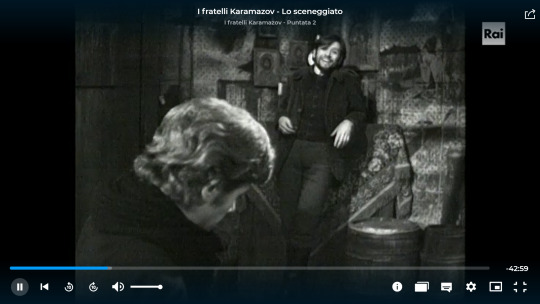
literally no one's doing it like him. later in this scene he asks alyosha if he was falling asleep while he was recounting his military adventures
#on another aside while im prepping to translate the next bit of the first episode: does anyone have an english copy of tbk#for (cough) lending (cough) purposes#so i can compare the bits they lifter from the book and be as faithful to the english translation as possible#its not urgent! most of the first episode is original stuff and ive translated just a couple of scenes anyway#just putting my hands forward#the brothers karamazov#i fratelli karamazov#mitya karamazov#alyosha karamazov#sam.exe
10 notes
·
View notes
Text
one exciting thing for all involved is now that i've read the idiot i can finally get to the film adaptations that include
- a rewatch of zulawski's l'amour braque
which i am most eager to get to out of all three because it's more of a homage / inspiration than direct adaptation also i have the security of already having seen it. it's not my favourite zulawski but i think i might like it better the second time. and i really like that compared to the book l'amour braque ends on a positive note at least that's the way i remember it. which made me realize actually that while zulawski films are generally full of depraved disgusting insanity they tend to have a positive ending, considering. and it's unavoidable to compare a bit because of course while reading i had the film in mind constantly and at first i thought the film's tone was just the zulawski signature craziness but actually the idiot turned out be really funny -save for the soul destroying ending- like i expected the heaviness of crime and punishment all throughout but it actually made me laugh a lot... on that note i thought the 'group of unhinged characters following the main character around, constantly screaming crying throwing fits and being ridiculous' was a zulawski invention since it's present not only in l'amour braque but in his other movies BUT it literally is there in the idiot already vsgshsbxhshdwjs great minds think alike. and now that i've mentioned the crying i think the film matches the book's general hysterical energy. connected to this i think a big problem with the other two adaptations i will get to in a minute will be that they'll mess up natasha's -or whatever the english translation of her name is- character. like call zulawski a misogynist because he was but he did know how to film women with all their ambiguity inexplicability complexity and it is very true of sophie marceau's natasha i think. which might be missing from the other two versions as they were made in the beginning and the ending of the 1950s. which will be fun to compare now that i think of it but i am nevertheless a bit afraid she'll be reduced to a damsel in distress trope or whatever but then again you never know. and now that i've introduced them next item is
- 1959 italian tv adaptation
with gian maria volonté as rogozhin which is...................................................can't wait to get to it as soon as i calm down and lower my expectations. i remember a carla gravina interview where she says that when she saw him in it she couldn't decide whether he was really bad or really good. well she says something like he was 'like a dog' in it which i don't know the meaning of but i believe women. logically there's just probably something lost in translation but if she did mean dog as the literal animal on further thought it's kind of the vibe needed for the character. hyped
- kurosawa adaptation
with toshiro mifune as rogozhin this time AND setsuko hara as natasha which is !!!!!!!!! crazy. and i've been wanting to watch for YEARS but i wanted to read the book first. i have my doubts and fears with this as with the previous one, as indicated above, but it will be worth it either way for this lineup i'm sure. well let's not lie all three will be worth it for the sake of analysing and comparing them in my head
busy schedule for this year! but i will be viewing
10 notes
·
View notes
Text
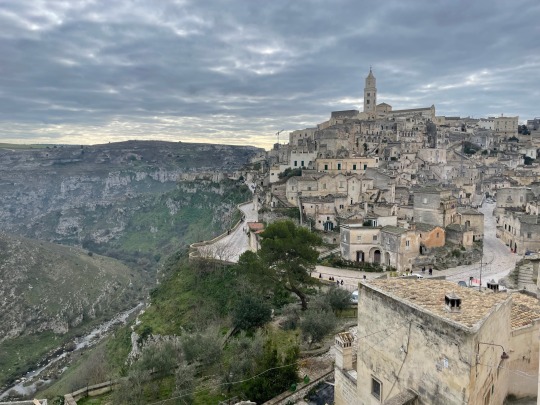
A Sojourn in Italia - Days 64 & 65 - Matera
Luisa has blogged about our drive through Alberobello and how we decided to give up and drive directly to Matera. On our way there, we were desperate to find a bar for both a toilet and for some lunch. Somehow the quiet country roads we were traversing did not have much to choose from. For example, following one sign to a pizzeria on a side road simply led us to a closed restaurant. We finally found a small bar open at about 1:30 and tried to order a couple of panini. The woman serving us apologised profusely but said that they were out of the small rolls that are used to make them and the only bread she had available was some sliced white bread (I didn’t think it even existed here!). I don’t think she expected us to accept the offer, but as Luisa said “quando si ha fame si deve mangiare ciò che è disponibile” (when you’re hungry you have to eat what’s available). The woman made us some toasted sandwiches with Mozzarella and Prosciutto. They were surprisingly good, the white bread letting the filling dominate. But what’s funny about this is while we sat eating our sandwiches, three other Italians individually refused the same offer preferring to go elsewhere. (see, sliced white bread really isn’t a thing here!)
Matera on the other hand was so good we decided to stay for an extra night. If some of the images look somewhat familiar, then you have probably watched one of several dozen movies that used Matera as their location. Perhaps two of the better known ones are the remake of Ben Hur. (2016) and the James Bond movie, No Time To Die.
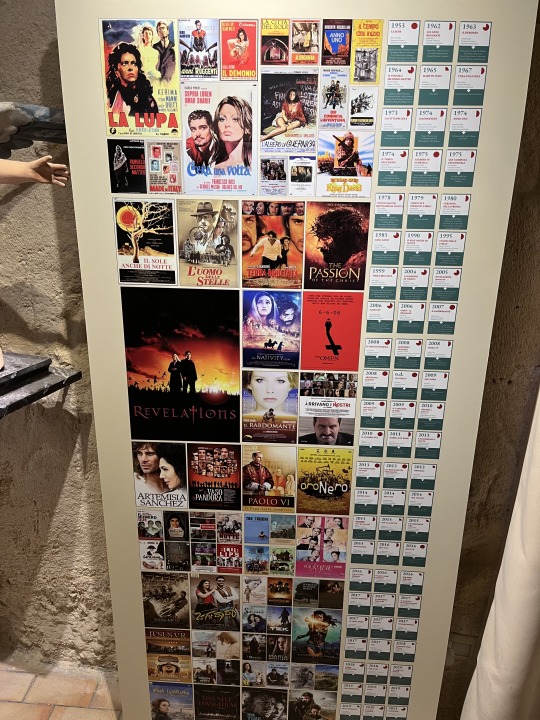
The original settlement of Matera lies in two canyons carved out by the Gravina River. This area, the Sassi di Matera, is a complex of cave dwellings carved into the walls of the ancient river canyon. Over the course of its history, Matera has been occupied by Romans, Longobards, Byzantines, Saracens, Swabians, Angevins, Aragonese, and Bourbons.

Matera is a World Heritage listed site and is most certainly picturesque, but its history is complicated. Lonely planet says that it’s perhaps the third-longest continuously inhabited human settlement, having first been settled in the paleolithic era, about 9,000 BC. It’s almost certainly the first inhabited area in Italy. As well as having abundant game in those times, the natural caves in the gorge are an attraction with the soft rock making it easy to both expand the existing caves and to create additional ones. The gorge is full of caves as are the lower sections of the main city. But in the mid 20th century, these caves were also a symbol of the poverty of Southern Italy. The region fell into poverty from the mid 1800s. In 1950, the Italian Prime Minister Alcide de Gaspari visited the area and was shocked, calling it the “shame of Italy”. He set about building new housing and forcibly moving the people out of the caves into the new homes. Only in 1962 were people allowed to reuse the caves and only if they fully restored and renovated them at their own expense. The main restoration of the area really began in the 1980’s with money from the EU, UNESCO and Hollywood!
Matera wasn’t always so poor, its had periods of splendour including during Roman times as a city either on or close to the famous Appian Way (I haven’t been able to quite clarify whether Matera was on the Appian Way or close to it, but either way it was an important Roman City). While the region was in deep poverty following WW2, its history is rich and the Sassi originally had good dwellings.
We arrived in Matera about 2:30 on Saturday afternoon and booked into our hotel. We’d deliberately chosen a modern hotel both for comfort and to keep costs low and because we did not want yet another AirBnB - some had not lived up to expectations. Our hotel was about 1.4 Km from the old city and an easy walk (no hills!). So we checked in, dumped our luggage in our room and headed off to the old city. We walked for about 1km towards what we thought was the centre of town, quite confused about the busy street which was quite contemporary, and what we’d read about the timelessness and very old age of Matera. We finally found a bar where we could stop, get ourselves an apperativo and check the maps we’d picked up at the hotel. Reassured the we were on the right track, we headed off up the road
We didn’t quite know what to expect but discovered that the Mercatino di Natale (Christmas market) was surprisingly still operating and that the place was full of people including many Italian’s who had decided to make use of the long-weekend. As the Friday was a festival day and a Public Holiday (the day of the Befana), this was a long weekend in Italy (they are rarer than in Australia as the Italians do not change public holidays to create long weekends and if the day falls on a weekend, then there’s no week-day catchup.)
As we wandered through the market, we came to the end of the road and a balcony where we could look over the the "Sassi di Matera" (the ‘Stones of Matera). It was an amazing sight - a crazy network of old, old buildings and narrow, cobbled streets. The Sassi were first settled in prehistoric times, and these dwellings are thought to be among the first ever human settlements in what is now Italy. So, of course, we set off down the stairs to explore the Sassi further. We wandered down into the heart of the tourist route through the Sassi, finally making our way up to the Duomo on the other side (the Duomo is the main church in any Italian city). The duomo was closed, so we stood with a crowd of people looking back towards the west watching the sun set.
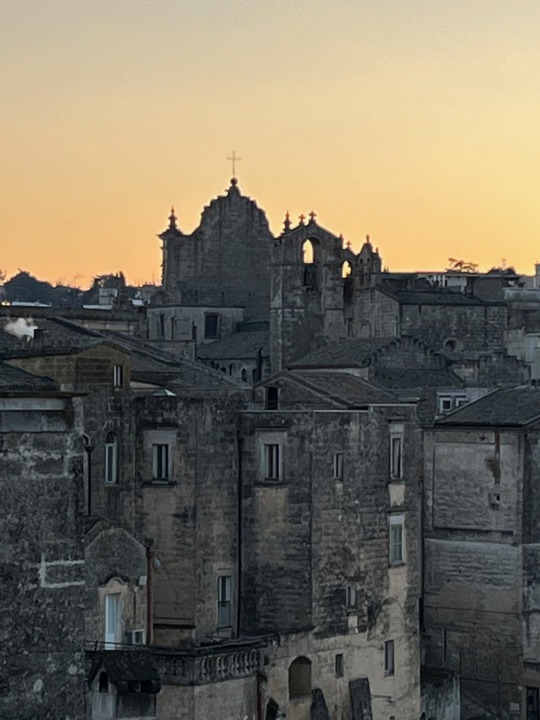
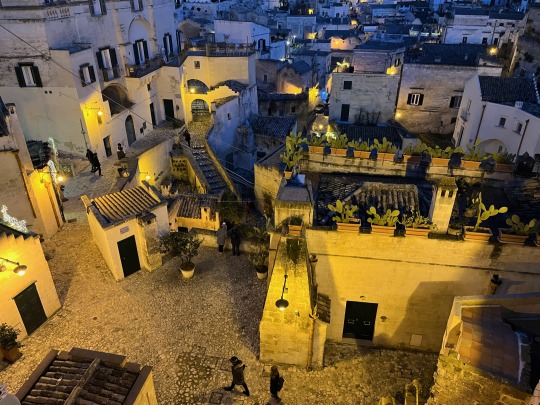
Some of the highlights of that first day:
We stumbled on the Chiesa di San Vitto al Lombardo, an old rock church that had been built in the 13th century (there are dozen of churches here in Matera which were built in the caves hundreds of years ago).
As we made our way to the Duomo, we heard the wonderful bells of its bell tower on the way. The Duomo is located in the Sasso Barisano area and habitation of this area in the high Middle Ages. The Duomo itself was built in the 1200’s, reaching completion in 1270.
We visited one of the old cave dwellings on our first day. The guide at this cave was able to give us a little information but we didn’t really get a sense of what living there might have been like.
We walked quite slowly (very rare for Luisa) because the rocky streets and stair were so slippery. I slipped on one occasion losing my footing despite wearing my Merrell boots which usually grip well. We both started slipping on numerous occasions as the paths are so worn that they are shiny. Luisa kept wondering about how many bones have been broken on these streets over the centuries.
Another church we stumbled across was the Chiesa San Giovanni Battista, a lovely old church, built in the 13th and 18th centuries. We spent some time in the church, listening to two musicians practicing on the organ and sax. It was peaceful, lovely and an appreciated break from all our walking.
After the sun set we decided to head back to our hotel and hopefully find somewhere to eat along the way. We were having no luck on our route until we passed by a panificio (bakery) specialising in sour dough. The has been operating since 1890 and is currently run by the great grand daughters of the original baker. We feasted on beautiful sour dough focaccia topped with artichokes and mushrooms, and a prosciutto and cheese strudel. The panificio was Il Forno di Gennaro.
Day 2:
The next morning after a satisfying breakfast at the hotel we set off to explore various parts of the city. Expecting to follow one route, we found ourselves going our own way to join the route we’d originally planned for the second part of the day, at its other end. Mainly we walked a route around the edge of the town, but we also revisited parts of the centre.
Some standouts in no particular order:
We visited another cave dwelling. This one was different to that of the first day being set up with a video and laid out like an original family dwelling. The video was a description of the life of a man who had lived in the cave as a young boy, his recollections of his life and homage to his father. The dwelling was set up with all the furniture and models of animals that the people who lived there would have raised. While it looked clean and fresh, the reality for the family which resided there would have been very different: the whole family lived and slept in the one room, with one bed for the parents and the eldest child. The other room had a single bed for another child and the baby slept in either a small crib or sometimes in the drawers of the old dresser. The second room (with the single bed) was for the animals which lived right there with the family - chickens which ran around the house, the donkey and a couple of pigs.
From the late 1800’s families in these cave houses lived in absolute poverty. As noted before, the government stepped in in the 1950’s and moved them to more modern accommodation. It’s hard to imagine what that process would have been like; to be taken away from everything that was familiar including the local community and probably their animals but to have access to a healthier and larger living space.
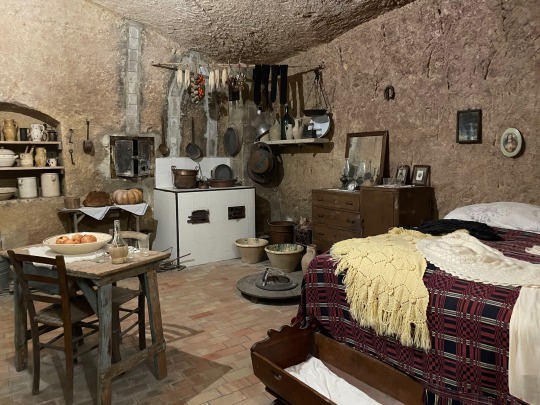

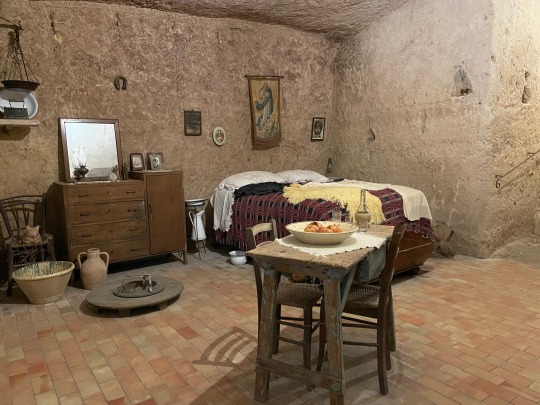

This article from the Guardian in 2017 gives some more information about these forced moves and how the Sassi have been revived - largely at the behest of a group of children who remembered the community values of the Sassi as well as the poverty and fought to have them restored. See:
To our surprise we came across several Dali statues during our walks. These were unexpected and a delightful surprise. As far as I can tell, the Dali exhibition in Matera was set up as part of it’s role as a European Capital of Culture and I think the exhibition was meant to be shown in early 2020. Of course Covid shut all that down and it seems that the exhibition has been held over to 2022. It’s destined to finish at the end of January 2023, but I suspect that the major works that have been set up in the piazza’s may be destined to remain they sure look permanent.
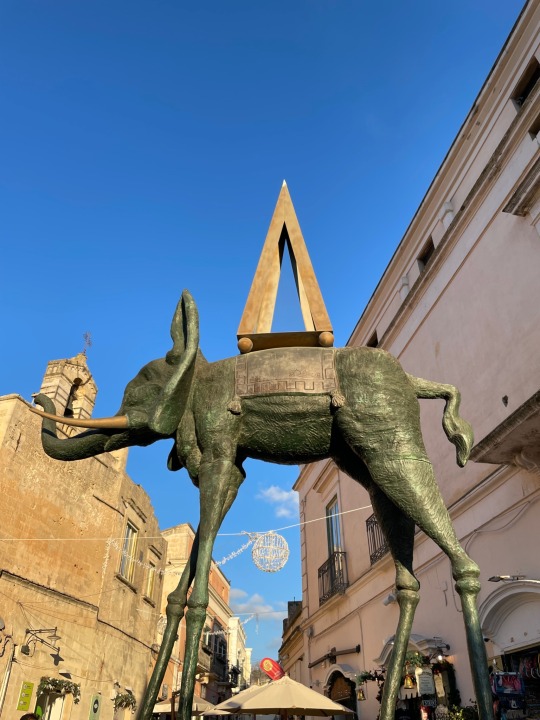
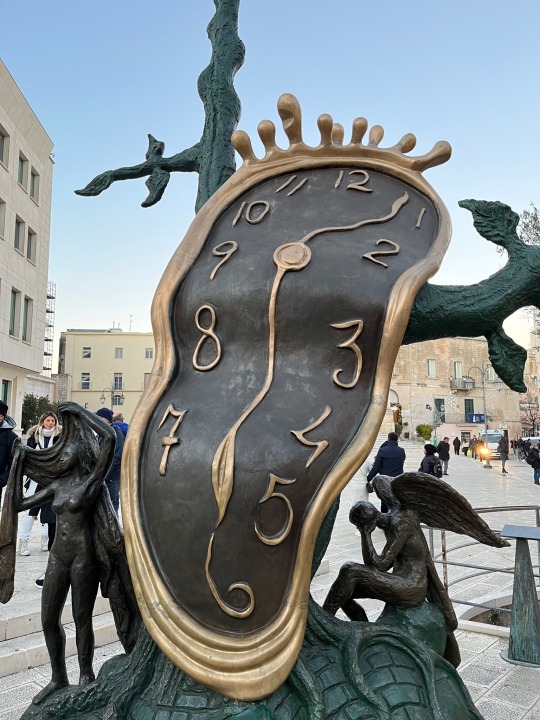
Another surprising find was a gallery of Nisio Lopergolo. As we walked through the Sassi, I noticed a couple of wooden carvings in a side street and we wandered up to have a look. Signore Nisio Lopergolo invited us into his gallery which is within one of the original cave dwellings. Nisio is a ceramic artist and sculptor and his work is very different to many of the other workshops/shops around Matera. He is an artist and he has received awards for his work. The pieces were stunning and also fascinating, and he took the time to explain some of the pieces to us.
One such piece which Nisio showed us was the Coppa di Pitagora (Pythagorean cup) or Justice cup. This cup is reputed to have been invented by the Greek philosopher and mathematician, Pythagoras, who wanted to convey a message of fairness to his countrymen, urging them to not be greedy but to be fair and balanced. The cup can be filled up t a certain point marked inside, but if it is filled beyond this point, all of the liquid is expelled completely through a hole at the bottom. As they say, “Grasp all, lose all”. Another design was a wine decanter that delivered a precise amount each time you pour out from it.
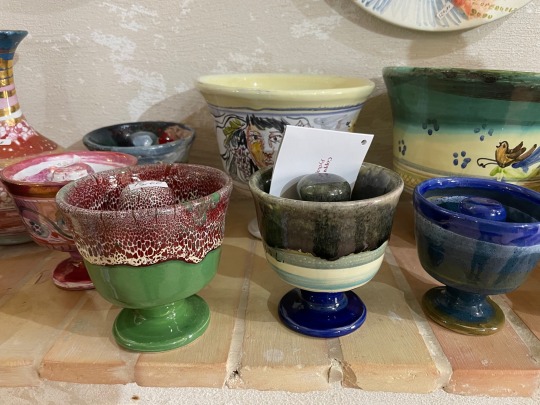
Nisio has carved figures into the walls and ceilings of his cave - you can see some of the figures on his website.
Later we made our way to the edge of Sasso Barisano, Civita, Rione Pianelle and Sasso Caveoso. We could see the caves on the other side of the canyon, and the paths leading down to the bottom of the canyon and over to the other side. Luisa was briefly tempted to walk the winding track down and over to the other side but it was only a very fleeting thought (we were both pretty tired by then).
Finally it was time to find a restaurant for lunch. But what we had forgotten was this was domenica (Sunday) and it seems that most Italians go out for Sunday lunch and booking a table is mandatory to secure a place. After unsuccessfully trying several restaurants including some rather pricy options, we finally settled on an unassuming bar/cafe, mainly because it was the only bar/cafe we found that advertised meals other than taglieri (platters of salumi and cheeses). Well weren't we in for a treat! My dish was a fantastic dish of Italian sausage cooked with carrots and cabbage in a paper wrap. While perhaps sounding unassuming it was wonderful. Luisa on the other hand, tried the baccala. Baccala is a dish made from dried salted cod and is not a traditional Puglian dish. But Luisa loves baccala and was interested in trying this variation on the traditional Venetian dish. It was delicious, with the cod being cooked lightly in a tomato based sauce (traditionally it's a cream or milk based sauce). We also tried out a dish of ceci neri cooked with wild chicory (delicious).
After lunch we walked up to the castello. Unfortunatlety it was closed and the path was very slippery. As you might expect the moat is empty but Luisa says she’d love to see a castle with a full moat!!!
We were better prepared for dinner that night. We’d bought a couple of bread rolls in the morning and we ate them for dinner - with a Puglian smoked cheese called caciocavallo, mixed lettuce and the last of our biscuits. And the chocolate we’d bought at the Mercatino di Natale which had been ridiculously overpriced and was actually pretty ordinary.
The next morning we headed back home via the autostrada. An interesting experience was at the payment gate on our exit. The machine could not read our entrance ticket (you grab a ticket from the gate on entering and autostrada and the exit gate reads this and works out your fee). We’d only noticed that the gate was broken after we’d driven in - it looked like someone had given up and driven through, so I don’t think our 's was the only ticket it couldn’t read. Anyway, you must not exit the vehicle and you must not try to back up. Help is via an intercom and in Italian. In my broken Italian I managed to explain that it could not read our ticket and eventually worked out that I was being asked to tell the man at the other end what the entrance location printed on the ticket was. He quickly entered the price manually from his terminal somewhere in the ether, the machine that couldn’t read our ticket read the credit card just fine and with the clear mechanical “Arrivederci” telling us it was fine to go we exited the gate.
2 notes
·
View notes
Text
Hermanos Conde 2021 “Media Luna” Flamenca Blanca
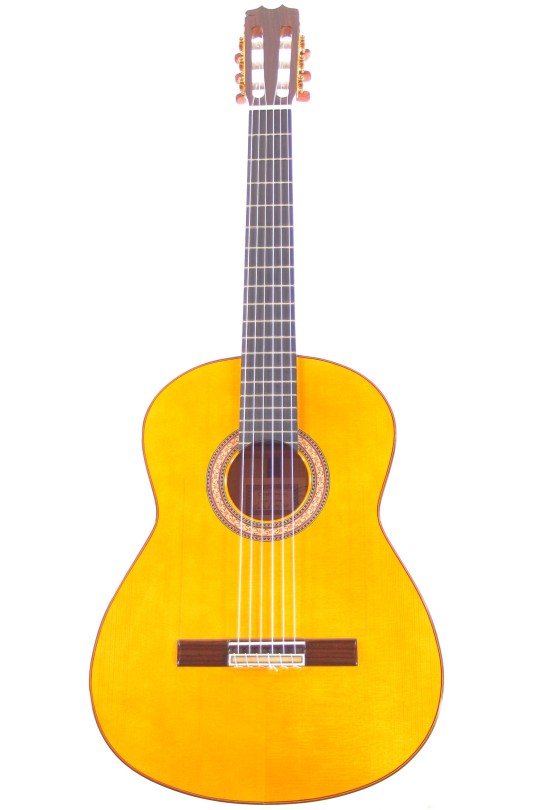
Spectacular sounding Hermanos Conde flamenco guitar. The real flamenco sound for professional players!
The story of the famous Hermanos Conde (Conde brothers) begins with Domingo Esteso. He belongs to the most important and famous guitar builders of the early 20th century. In 1917 he opened his own workshop in Calle Gravina 7 in Madrid. There he worked from 1926 with his nephew Faustino Conde and later with Mariano and Julio Conde.
Domingo Esteso Lopez died in 1937, but Faustino Conde and his brothers Mariano and Julio continued to run the workshop under the name “Vda y Sobrinos de Domingo Esteso” and then later under “Hermanos Conde Sobrinos de Domingo Esteso”.
As the demand for guitars increased, another shop was opened in Calle Atocha 53, for which Julio Conde was responsible.
This shop still exists today, although the shop in Calle Gravina 7 has been closed in the meantime.
This Hermanos Conde guitar was built in 2021 and is the perfect example of a good Conde flamenco guitar.
The top is made of best spruce wood and the back and sides of finest Spanish cypress. The nut width is 52 mm and the scale length 655 mm.
The neck is perfectly straight and the action is super flat at 2.7 mm E6 and 2.2 mm E1.
The sound of this Hermanos Conde guitar is fantastic. Powerful, hearty and full. At the same time the guitar is very balanced and clear. Cypress wood is so original for flamenco guitars and here we find the perfect example of a flamenca blanca. It has all the qualities a professional guitar player expects.
It has the power of the great Madrid guitars of the 60s and 70s.
The guitar is in new condition.
A hard shell case comes with this beautiful Conde Hermanos.
Read the full article
3 notes
·
View notes
Text
Volunteer, Foster, and Rescue some sort of Life!
Volunteering a tiny of some location is definitely crucial to BOOK MARKING feline lives.
Last summer, My partner and i received a message via my feline sitter, which likewise runs a feline rescue: "Hey. My partner and i possess nine kittens that need an area to crash for a couple of weeks. Can you assist? " I panicked for a new minute. My partner and i wanted to be able to say yes. Nonetheless I actually had no suggestion approach foster kittens and currently had a houseful of resident in town pets. But typically the kitties experienced no place to go, so I actually agreed. In the stop, my family together with My spouse and i were astonished in accurately how easy (and pleasant! ) it was to keep up and interact socially with the little cuties and make them for their forever homes. Although we had been uninformed entering into this, our earliest foster work was a smashing accomplishment.
WHY FOSTERING CONSERVES LIFE
Pet welfare companies concur that an essential component of conserving animal lives is cultivating when an person or house takes in an animal from your sanctuary or maybe rescue and even cares for him, either with regard to a good brief period or perhaps until the animal can be accepted. Based on the ASPCA, a great estimated 3. 3 million felines get in animal sanctuaries throughout the region every year. About 860, 500 (more than 25%) involving those felines are euthanized lots of unnecessarily credited to lack of room or maybe resources.
But dog health and wellness professionals think the fact that fostering may change that percentage. "If just 2% associated with pet-owning people would definitely foster one pet dog a new year, we would definitely end unnecessary assisted committing suicide tomorrow, " states Susanne Kogut, president of the particular Petco Foundation. This not-for-profit has invested greater than $250 thousand to support the lifesaving activities of pet well-being organizations throughout the country.
VARIETIES OF SERVICE
While fostering is a somewhat easy means to support household pets, quite a few people have a tendency know what it requires. Thankfully, agencies that count on foster caregivers try out to make it easy for people to obtain engaged.
A good lot of potential fosters are ruffled, says Palma Gravina, typically the senior volunteer manager on North Coast Pet Addition America, in Port New york, New You are able to City. This company supplies teaching to aid it is advance caretakers and lots involving the help of veterinarians and behaviorists about staff. "We explain to our foster family associates, 'You're by no means alone! '" Victoria claims.
Maddie's Pay for, a national foundation committed to providing a good no-kill country, also pinpoints the fact that education and learning remove obstacles to individuals approaching to be advance household members, so they now have created the extensive on the internet repository maddiesfund. org. Now there, foster caregivers and shelter or relief team are able to find assets about endorsing, looking after animals, and supporting foster family associates.
In addition to training, many sanctuaries in addition to rescues supply foodstuff and materials and handle the price of veterinary clinic care of the promote animals, which is a good regular concern for future foster households.
VARIOUS PROMOTE SITUATIONS
Pet kittens and cats, because well as kittens, include the selection of foster remedy demands. Some require a good spot to remain for an evening as well as a few weeks, while other people call for a dedication of several months. Pet shelters would like to help make the cultivating expertise favorable and work with caretakers to uncover a good situation most convenient their way of life. "If a person tell me personally you have just 2 weeks to help, I'm not really likely to send you household with bottle-feeding kittens which can not be taken on for another 30 days or maybe more, " says Erin Steen, foster manager with Best Buddies Animal Traditions around Kanab, Ut. "My job is to possibly be versatile and fit people up with the pet read that right for them. inch
Felines of each and every age get from foster treatment, statements Gemma Cruz, administrative director in the particular ASPCA Kittycat Baby Area. The request for kitten helps bring about rises appreciably during the "kitty time, " or cat breeding season, which occurs during the country through springtime and summer, the girl describes. Sanctuaries and will save working experience an increase connected with kittens as well as require create families in order to action in and aid.
IMPORTANT INTENDED FOR KITTIES
Shelter surroundings normally are not helpful for kittens, that is why foster homes are as a result vital for felines this kind of youthful, says Kelly Duer, advance care professional together with Maddie's Fund. Kitties call for to get made sterile as well as sterilized before they proceed up for use, which does not take location very much they've gotten for you to about 2 pounds as well as eight weeks of time. "Yet their premature system proof systems can't do away with shelter-borne diseases, " your woman examines.
For orphaned, bottle-fed young children, the need with regard to foster caretakers can be also more critical. Most sanctuaries do not have adequate personnel or volunteers in order to bottle give food to every few of hrs, as a result engender family members are typically the kittens' only chance at survival.
When their own basic needs are attained, hanging around with individuals may be the very best means to prepare kittens to get fostering, even if they can be nervous. In a shelter, explains Erin, the already-shy kittens could never grow to be interpersonal. "It would certainly be solid for shelter staff to pay sufficient period to make them experience comfortable and also protected, " the girl includes. Nevertheless, in a engender property, numerous kitties can easily effortlessly find out to depend upon people.
HELPING ADULT CATS AND KITTENS
It's not merely comfortable, very little kitties that will need foster buildings. Adult pet cats, particularly those recovering from surgical procedures or perhaps ailments, are extra relaxed and heal much quicker in a foster house, Kelly claims.
Still, some others, who else aren't at his or her perfect in a retreat environment, typically do substantially better in a instill house. "Also, in the particular best shelters, lifestyle to get family pet is difficult, and also, this can result in pets' habits in order to become weak, placing their life on risk, " Kelly covers. "Foster treatment is the particular means to fix every one connected with these problems. "
Claims Triunfo, foster houses support felines and kitties to help flourish. "It provides typically the prospect to reveal could possibly be true persona as well as eventually gives pet the second opportunity. inch
And they all are entitled to 1, accomplish definitely not they?
Is usually Promoting For You?
Fostering isn't very for everybody, and which is just fine. However, a lot of people could well be amazing fosters if they opted for attempt it out.
Inquire alone these concerns in advance of starting:
you Do a person own your residence, as well as does your proprietor make it possible for pet dogs?
Ensure your dwelling predicament will be reactive to having some extra proprietors around, as they may well exist anywhere from two to eight 2 or 3 weeks, relying with what grow older and requirements the pet cat or maybe kittens may possibly have.
3 Do you have the designated place in your house?
Kittycats do not call for much bedroom; also, a washroom might be a right, risk-free place to get young kittens. Older felines don't often need a lots of parts either. If you possess citizen pet dogs, especially, be sure your current break feline connected to help their very own, like a great further bedroom or restroom, in which this individual can proceed to feel free of risk.
3 or more. Are you able to hang about with typically the pet dog?
Even those who function full-time tasks could be great fosters if they may hang around with their foster creatures once they get property. Between the most crucial characteristics of an foster are mingling socially with the kittens or felines, so they feel as cozy like possible around humans. Several grown-up pet cats bloom in residence set upward, allowing the foster loved ones to see the pet cat's genuine personality! After that, many people can share that will together with prospective adopters, supplying a great incredible feeling of what the cat is all concerning.
4 Is it possible to take the particular pet to veterinarian appointments and also usage occasions?
While the refuge or even attempt usually covers treatment, promote caretakers need for you to be prepared to do the foster animal to the particular veterinary when needed. Instill moms and dads might likewise be asked to deliver the animal to promoting activities.
cat food
1 note
·
View note
Note
good to know 😁. Yeah that's what pisses me off, lots of the players all play for big clubs and the team has much potential, but they are wasting it. I don't expect everyone to be best friends, but whatever issues they have it needs to stop and they need to speak up as a team. Oh I don't think it's out of pettiness (tho some of them treating Yaya horribly surely was 🤐), but more like keeping their spot on the team safe by staying silent. Tbh if figc did extend the former coach's contract, Yaya would still be blacklisted. The location sucks but it's not suprising because Gravina (the federation's president) is the town's honorary citizen. He also coached their team and was involved in several scandals when he did. There even is a book about it called: The miracle of Castel Di Sangro. Spoiler alert and not suprising, Gravina is a horrible piece of trash.
Oh wow, that just sucks
0 notes
Text
The FIGC needs major overhauling and it needs to be done ASAP or Italian football, from the men’s, to the women’s, to the youth, and even Serie A, are going to continue to be in the situation we’re in right now.
We have lost every single final we’ve been to (bar the u19s, bless those boys for brining me some joy in life this year), or have been knocked out of every competition way earlier than we should have been. I’m still majorly upset over the entire u21 drama. A team which, in my opinion, bias or not, was so strong that they could have and SHOULD have been competing for the trophy and make it very far in the tournament. Yes, we were absolutely robbed against France, but losing to Norway was unacceptable. Le Azzurre are now also out of the World Cup in the group stages, when last WC they made it all the way to the Quarters.
There was no reason for any of them to be eliminated in the group stages. This is the fault of technical errors made by the coaches. Whether it be calling up the wrong people and not calling up the right ones, poor tactics, and/or, poor lineups/subs, if I see a pattern, my blame always lands on the coach first.
These players are talented. They can all get very far and win trophies if their true potential is exploited properly. But this can’t happen under the current federation we have, and especially not with Gravina still in charge.
We are stuck playing a style of football that is boring and old. If we don’t catch up with the modern style, as every other team is doing, we will be left in the past with no way toward the future.
1 note
·
View note
Video
Matera, Italy, January 2016 1092 by Tiberio Frascari
Via Flickr:
Matera is a city and a province in the region of Basilicata, in southern Italy. It is the capital of the province of Matera and the capital of Basilicata from 1663 to 1806. The town lies in a small canyon carved out by the Gravina. Known as "la Città Sotterranea" (the Subterranean City), Matera is well known for its historical center called "Sassi", considered World Heritage Site by UNESCO since 1993, along with the Park of the Rupestrian Churches. On October 17, 2014, Matera was declared Italian host of European Capital of Culture for 2019.
0 notes
Photo

Gibson Gowland and Jean Hersholt in Greed (Erich von Stroheim, 1924)
Cast: Gibson Gowland, Zasu Pitts, Jean Hersholt, Dale Fuller, Tempe Pigott, Sylvia Ashton, Chester Conklin, Joan Standing, Cesare Gravina, Frank Hayes, Fanny Midgley. Screenplay: June Mathis, Erich von Stroheim; Joseph Farnham (titles), based on a novel by Frank Norris. Cinematography: William H. Daniels, Ben F. Reynolds. Production design: Erich von Stroheim.
One of the legendary mutilated masterpieces, Greed isn't one film but several, most of which are lost. The gravest loss would have to be the original 42-reel cut (about eight hours) of the film, which was seen only by a handful of people, several of whom were the first to call it a masterpiece. What we're most likely to see now is the 1999 reconstruction of the film, gathering the scenes that remained after various hands cut it down to about 10 reels (about an hour and 50 minutes) before its 1924 release, which was a critical and commercial flop. After that, the footage deteriorated or was trashed, so the four-hour restored version is pieced out with what remained in various archives along with stills and other archival material. I have sat through all seven hours of Béla Tarr's Sátántangó (1994), but only because I could watch it over several nights. Unless Greed was served up as a miniseries, I'm not sure I would be willing to watch the original cut of the film: Even shortened it's an exhausting experience, not only because of the length but also because Erich von Stroheim's dedication to telling as much of the story in Frank Norris's novel as he could led him into some extraordinarily bleak places. The bleakest of those places literally is Death Valley, where the climactic standoff of McTeague (Gibson Gowland) and Marcus (Jean Hersholt) takes place -- a sequence that still has the power to astonish even when seen independently of the rest of the film. But much of the bleakness also lies in the characters of McTeague and Trina, especially the latter, whose transformation from sensitive, shy virgin to monster of greed is harrowing -- a reminder that Zasu Pitts, now best known as a comic character actress, was a performer of real skill. The restoration also includes the sordid subplot of the greedy junk dealer Zwerkow (Cesare Gravina) and his half-mad henchwoman Maria (Dale Fuller), which ends in murder and suicide. Balancing that was a sentimental subplot involving the McTeagues' rooming-house neighbors, the elderly bachelor Grannis (Frank Hayes) and the spinster Miss Baker (Fanny Midgley), who don't meet for a long time, even though their rooms are separated by a partition so thin they can hear each other's every move. If the junk dealer subplot serves to indicate the depths of degradation that threaten the McTeagues, the story of the lonely elders helps sweeten the film as they meet and fall in love, using a monetary windfall in constructive ways -- a counterpoint to Trina's miserly hoarding of her lottery winnings. Greed is a fascinating film, but I suspect that the story of its mishandling outweighs any significance it might have had if it had remained intact and coherent.
1 note
·
View note
Photo

Expositions - Surfer’s Paradise (released on Plastic Fantastic’s Youtube Channel, 2020)
#expositions#reuben smith#balearic#balearic beat#plastic fantastic#ambient#chill out#downtempo#ibiza#dreamy#doped out#spacey#forest jams#yellow haze#calle gravina#balearic social#polaroid#surfer's paradise#surfer#surfboard#waves#ocean#beach#clouds#sun#sky#horizon#hills#sun lounge#octagon eyes
150 notes
·
View notes
Text
“When Robert of Naples named Johanna his successor, he faced the lingering question of the Hungarian Angevin claim to Naples. Johanna’s sex left her vulnerable to charges that her reign was illegitimate and reignited charges that Robert had usurped his throne from his nephew, Carobert of Hungary. With these concerns in mind, and in the interest of stability, Robert arranged a compromise with the Hungarian Angevins: Johanna’s younger sister, Mary (1329–66), would marry Louis, Carobert’s eldest son and the heir to the Hungarian throne, while Johanna would marry Andrew. In 1333, Andrew, then only five years of age, came to Naples to be educated in what was widely understood as his future kingdom. Indeed, Robert preached a sermon in honor of his arrival on Matthew 3:17, greeting the young prince with the words, “This is my beloved son, in whom I am well pleased,” thus seeming to proclaim Andrew his heir.
…Andrew was called upon to acculturate, to find a place for himself in a distinctive, fashion-conscious court. To some extent, he must have done so, but court records and reports by observers suggest that he never became a true member of court society, and instead that he remained separate from his Neapolitan cousins, including his future wife, who slighted and mocked him. Indeed, numerous chroniclers report that Andrew was subject to constant taunts and humiliation. In 1343, Robert died, and the throne passed to Johanna. She was seventeen; Andrew was only fifteen. The court at whose head they found themselves was split into multiple factions that vied to influence, control, or supplant the young couple. The most prominent divisions were between Provençal and Italian (primarily Neapolitan and Florentine) courtiers and the Hungarians who had accompanied Andrew to Naples and gradually won their own supporters.
Added to this already volatile mixture were the three Tarantini (descended from Philip of Taranto) and three Durazzeschi (descended from John of Gravina), who, as Angevin princes, had hoped to succeed ahead of Johanna or to ascend the throne through marriage to Robert’s granddaughters—something that likely sharpened their resentment of Andrew. It was in the interest of the Hungarians to garner as much power and influence for Andrew as possible and in the interest of the other factions—particularly the Tarantini and Durazzeschi—to prevent this. Robert had foreseen that factionalism might lead to chaos. Under the terms of his testament, neither Johanna nor Andrew was to come into their full inheritance before the age of twenty-five—long after the customary age of majority. Until then, they would be guided by a governing council appointed by Robert and overseen by Sancia. The council included Robert’s closest advisors, whom he trusted to guide Johanna until she was ready to rule alone.
This state of affairs was unsatisfactory to all of the factions. Johanna, for her part, balked at the unusual provision in Robert’s will that barred her from attaining her majority at eighteen. Andrew and Johanna had both already reached the age of discernment, customarily set at fourteen. Neither, therefore, was a child according to conventional definitions, and neither welcomed subjection to the governing council. Pope Clement VI (r. 1342–52) was disturbed as well by the creation of the council, which usurped his suzerain rights over Naples and his prerogative as Johanna’s legal guardian—something Johanna herself clearly recognized. Shortly after Robert’s death, she wrote to the pope, requesting that Andrew be awarded the title (though not the power) of king, most likely with the intention of ingratiating herself with the Hungarians and shortening the term of her minority. Clement refused.
In papal correspondence, Johanna was entitled regina Sicilie, a title Sancia also retained. Clement seldom addressed the governing council, which he resented, and only rarely addressed Andrew in his letters during the period immediately following Robert’s death, a clear mark of his reluctance to recognize Andrew’s claim to kingship. Papal interests were best served by maintaining firm control of Johanna and checking the ambitions of the Hungarian Angevins. Clement was thus faced with overseeing a contentious dynastic situation in a valuable papal fief. This task became increasingly difficult, particularly after the rivalry between the Tarantini and Durazzeschi was exacerbated by the clandestine (and possibly forced) 1343 marriage of Mary of Naples (then only thirteen) to Charles of Durazzo (1323–48).
Mary stood second in line to the throne; the marriage, which made Charles the husband of Naples’s possible future queen, violated the terms of Mary’s betrothal to Louis of Hungary but had tacit papal approval. Naples became a hotbed of intrigue that threatened to erupt into open feuding. Clement VI was obliged to maintain constant contact with the Neapolitan branches of the Angevin family, with Johanna and her advisors, and with the increasingly irate Hungarians as he struggled to sustain the fragile peace within this most dysfunctional of families. The Queen Regnant and Her Prince-Consort Johanna’s attempts to maintain good relations with Andrew and his family ended soon after she ascended the throne. Robert had ruled alone, refusing to share his administration with his brothers, who received the duchies of Taranto (in southern Italy) and Durazzo (in Albania) as their patrimonies.
According to Robert’s testament, Johanna was to rule as the sole inheritor of all of her grandfather’s possessions, delegating none of her power. The Hungarian Angevins might have planned to rule Naples through Andrew, but their designs were thwarted by Johanna’s refusal—supported by both the governing council and the pope—to allow him to be publicly entitled king, to swear fealty to the papacy, or even to control his own finances. Andrew was commonly referred to in person and in correspondence as “king,” but this was merely a mark of courtesy. Only the pope could confer the regal title, and Clement VI declined to do so. Johanna treated Andrew as her consort rather than as a co-ruler, thus assuming her grandfather’s position and consigning Andrew to that formerly held by Sancia.
…While Johanna’s actions and those of the governing council fulfilled Robert’s wishes, they were unusual enough to draw critical notice and at variance with what Robert’s intentions had seemed—at least to some contemporaries—prior to his death. Carobert had sent Andrew to be raised in Robert’s court with every expectation that he would eventually rule Naples. Léonard argues that Robert “had placed Andrew, as a child, on the same footing as his granddaughter; it could not have been to debase him before her for his entire life.” Yet, as Léonard also notes, Robert’s testamentary provisions incontrovertibly established just such an imbalance. Indeed, Andrew—who was entitled prince of Salerno rather than duke of Calabria, the title reserved for the heir to the throne—was denied the right to succeed to the throne even if Johanna predeceased him.
The question of Andrew’s rightful position would trouble Angevin politics long after his death. His supporters alleged that Robert had meant for Andrew to succeed him. They insisted that Robert had changed his mind about the disposition of the kingdom on his deathbed and made Andrew his heir. Such claims persisted throughout Johanna’s reign and intensified with Andrew’s murder. According to their arguments, Johanna was not the lawful heir to the throne—she ruled only through the unnatural debasement of Naples’s true sovereign, and her only claim to queenship was as Andrew’s consort. Andrew’s succession, from a certain perspective, was logical: It would have adhered to the hereditary principle favoring male candidates and mirrored the Valois succession in France.
Furthermore, it reflected the common practice by which powerful men ruled territories inherited by their brotherless wives. Andrew’s partisans, therefore, both before and after his death, could assert his threefold legitimacy as king by descent (through his grandfather), by inheritance, and as Johanna’s husband. These arguments would underpin narrative attacks on Johanna after Andrew’s death, when Andrew’s just claim to Naples’s throne became the backdrop against which the story of his murder was ultimately told. Thus, in the years between Robert’s death and Andrew’s murder, two rival arguments circulated about Andrew’s rightful position. According to the first, Andrew was Johanna’s prince-consort, not entitled and not equipped (due to his youth) to rule. According to the other, he was the legitimate king of Naples, designated by Robert as his immediate and sole successor.”
- Elizabeth Casteen, “The Murder of Andrew of Hungary and the Making of a Neapolitan She–Wolf.” in From She-Wolf to Martyr: The Reign and Disputed Reputation of Johanna I of Naples
#johanna i of naples#andrew of hungary#italian#history#elizabeth casteen#medieval#late middle ages#from she-wolf to martyr
15 notes
·
View notes
Text
Hi Folks. Do you like the horror genre?
I'm Nicolas "Nicky" Gravina. Though sometimes i call myself something else. I write horror rpg supplements,for the game systems called World of Darkness and Chronicles if Darkness. I write short supplements about vampires,werewolves and sometimes evil mages.
I should give trigger warnings for things like violence and tragedy. But otherwise what i write it's not terribly disturbing.
So if you are a horror gamer,my products are just for you 🦇
9 notes
·
View notes
Text
Hermanos Conde 2021 “Media Luna” Flamenca Negra

Spectacular Hermanos Conde flamenco guitar. A super sounding Flamenca Negra in the style of Paco de Lucia’s Conde!
The story of the famous Hermanos Conde (Conde brothers) begins with Domingo Esteso. He belongs to the most important and famous guitar builders of the early 20th century. In 1917 he opened his own workshop in Calle Gravina 7 in Madrid. There he worked from 1926 with his nephew Faustino Conde and later with Mariano and Julio Conde.
Domingo Esteso Lopez died in 1937, but Faustino Conde and his brothers Mariano and Julio continued to run the workshop under the name “Vda y Sobrinos de Domingo Esteso” and then later under “Hermanos Conde Sobrinos de Domingo Esteso”.
As the demand for guitars increased, another shop was opened in Calle Atocha 53, for which Julio Conde was responsible.
This shop still exists today, although the shop in Calle Gravina 7 has been closed in the meantime.
This Hermanos Conde guitar was built in 2021 and is new.
The top is made of best spruce wood and the back and sides of finest rosewood (exactly the same wood as Paco de Lucia’s guitar). The nut width is 52 mm and the scale length 660 mm.
The neck is perfectly straight and the action is super low at 2.7 mm E6 and 2.2 mm E1.
The sound of this Hermanos Conde guitar is fantastic. Powerful, hearty and full. At the same time the guitar is very balanced and clear. It has the power of the great Madrid guitars of the 60s and 70s.
Flamenco at the highest level is in this great guitar.
A hard shell case comes with this beautiful Conde Hermanos.
https://www.youtube.com/watch?v=IXUEzR84VhY
Read the full article
0 notes
Text
New episode at DataCafe.uk with guests Erika Gravina, Rajwinder Bhatoe & Dehaja Senanayake who tell us their story helping to create the Job Finder Machine with the Emergent Alliance, DataSparQ, Reed, and Google.
👉 https://datacafe.buzzsprout.com/1073626/8533165-data-science-for-good
#data science#data scientist#data scientists#programming#analytics#data analytics#coding#podcast#podcastlife#podcaster#podcasts
3 notes
·
View notes
Link

The FIGC has instituted a fund called the ‘Fondo Salva Calcio’ ('Save Football Fund') which is worth €21 million, with €5 million going to the Lega B, Lega Pro (Serie C) and LND leagues each, in order to help the teams through this crisis.
€700,000 will be given to Serie A Femminile to help all twelve teams finish the season.
The totals are for the leagues as a whole, and the funds will be divided among all the teams of the leagues.
Still, this is a good thing, especially for Serie A Femminile, as it means that the league has a good chance of restarting.
Still no word on whether the league will restart though. Hopefully, we’ll hear about it soon.
11 notes
·
View notes
